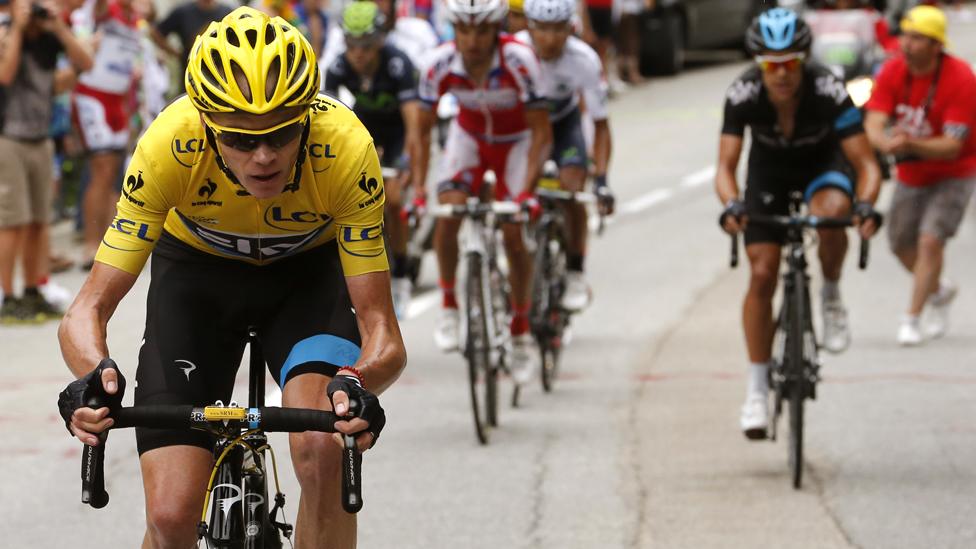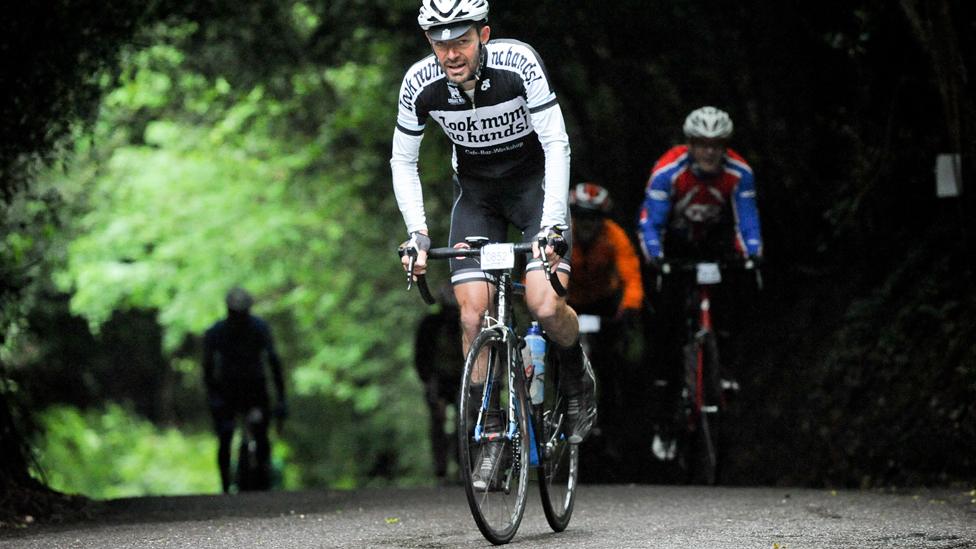Pedal power - the unstoppable growth of cycling
- Published

Will Smale (second from the right) and cycling friends
As many of us make getting fit one of our New Year's resolutions, the BBC's Will Smale - who is bike obsessed - takes a look at the reasons why an ever growing number of people, both men and women, are taking up the sport.
To adapt a quote from the cult film Withnail and I, I had gone on a cycling holiday by mistake.
An overweight, middle-aged man on a road bike in the mountainous wilds of mid Wales, looming above me was a stretch of tarmac called the Devil's Staircase.
The demonic name is apt, as it is a vertiginous wall of a road. It was squeaky Lycra time.
Putting my bike into its lowest gear, I nervously started the climb. Within seconds my legs were in agony and my lungs rasped for air.

The successes of Sir Bradley Wiggins and other British riders in recent years has greatly increased cycling's profile in the UK
Half a mile later, I finally reached the top, exhausted, but utterly elated. Hugging my four cycling companions, the holiday - cycling the length of Wales over three days back in June - was immediately wonderful again.
After doing next to no exercise for two decades, I bought a road bike in 2012 to get fit, and I have been an obsessive cyclist ever since. I love the challenge of long rides and steep hills, and the sociable nature of cycling with friends.
But why have so many other adults - both men and women - also caught the bug?
'Perfect storm'
More than two million people across the country now cycle at least once a week, an all-time high according to British Cycling, the sport's governing body in the UK.
For businesses in the cycling industry this means booming sales. At Halfords, which is responsible for one in three bikes sold in the UK, sales of its bicycles were up 11% in the year to 27 March 2015.

Simon Mottram is continuing to see sales soar at his cycling clothing brand Rapha

Rapha is seeing the biggest sales growth in its female clothing lines
This growth was led by the retailer's most expensive "premium bikes", which saw sales expand by 24.9%, following growth of 30% in the previous 12 months.
Meanwhile, sales of UK manufactured bikes rose by 69% in 2014, according to the Office for National Statistics.
Cycling clothing firm Rapha, which supplies the Team Sky pro road bike team, is another business to have benefited from the big increase in the number of people cycling.
The London-based business says its sales have grown by more than 30% per annum for 11 years in a row.
Rapha's founder and chief executive Simon Mottram says there are a numerous reasons, or a "perfect storm" behind the big rise in the number of regular cyclists in the UK.
"You can probably trace it back to the bombing attacks in London in 2005," he says. "The day after, the tube lines were all still closed, and suddenly there were lots of people on bikes to get to work.

Tour de France winner Chris Froome is keeping UK cycling firmly in the spotlight
"You got the impression that many hadn't ridden in quite some time, but then enjoyed it so much that they stuck to it.
"Then you have the effect of the 2007 Tour de France starting in London, the eight gold medals won by the GB cycling team at the 2008 Beijing Olympics, the 2012 Olympics in London, and of course Bradley Wiggins and then Chris Froome winning the Tour de France.
"Not to forget the government's Cycle To Work scheme [introduced back in 1999 and which allows people to buy a bike tax-free]. And the underlying increased focus on health and fitness, and concerns about congestion."

Claire Kearney (left) says she goes cycling as often as she can
Most media reports on the growing number of cyclists on the road focus on the so-called "mamils", which stands for "middle aged men in Lycra", and Mr Mottram says that while this group is a large one, his typical customer is a bit younger.
"Our average customer is a man in his mid-30s," he says. "Yet at the same time, our fastest-growing customer section is female road bikers.
"That goes under the radar, and it is still less than 10% of the business at present, but it is seeing the biggest growth."
Londoner Claire Kearney is one such woman who an avid cyclist.
The 35-year-old HR manager says: "I didn't own an adult bike until was 28.
"People I was working with at the time persuaded me to join them on a charity ride from London to Paris. So with only six weeks before the ride I said 'yes', bought a bike, and started cycling everywhere.
"I found the charity ride really, really hard to start with, but then I really loved it.
"Cycling is such an enjoyable and sociable form of exercise, and such a friendly sport. You can join a club, or go on a sportive [an organised ride], and meet lots of people, and everyone smiles and chats away."
'Doing deals'
But while a growing number of women and young adults are indeed taking up cycling, you cannot ignore the mamils.
With more disposable income that younger riders, they are the group that spends the most on their bikes, buying the ultra-lightweight carbon models, with the best gears and other high-end components.

Peter Murray (centre) says it is possible to talk business while cycling
And such is the continuing popularity of cycling among men over 40, that it has often been said in recent years that cycling is "the new golf", with cycle rides replacing rounds of golf as the preferred out-of-office activity during which business deals are agreed.
Architect Peter Murray, chairman of think tank New London Architecture, has been organising charity cycle rides for the past decade, including an annual ride from London to Cannes on France's Mediterranean coast.

Going for a cycle ride in the country can give you some wonderful views
The 71-year-old, who took up cycling when he was 51, says: "You can definitely do business deals on cycle rides. On one of the first rides I organised to the south of France, a group of young architects came along.
"One of them recently sent me a chart detailing all the work he had got from 10 years of joining the rides to Cannes.
"He had three people in his team originally, and now he has a growing office of 25 people. And almost every project he has won traces back to links he made on the rides."
Yet for other businessmen who are cycling obsessed, you should never talk shop while on your bike.

Chris Ward now competes in cycle rides across Europe
This is the opinion of public relations entrepreneur Chris Ward, 52, who bought his first road bike when he was 40, and now competes in the amateur world championships.
Mr Ward, who cycles an average 175 miles a week, says: "I'm happy to take business calls when I'm in a cafe, but not when I'm cycling. Cycling is for getting away from work."